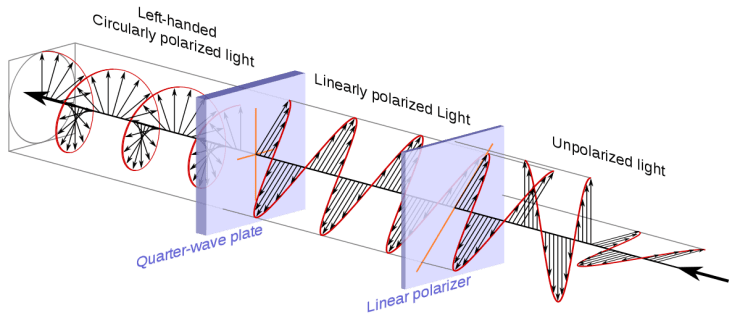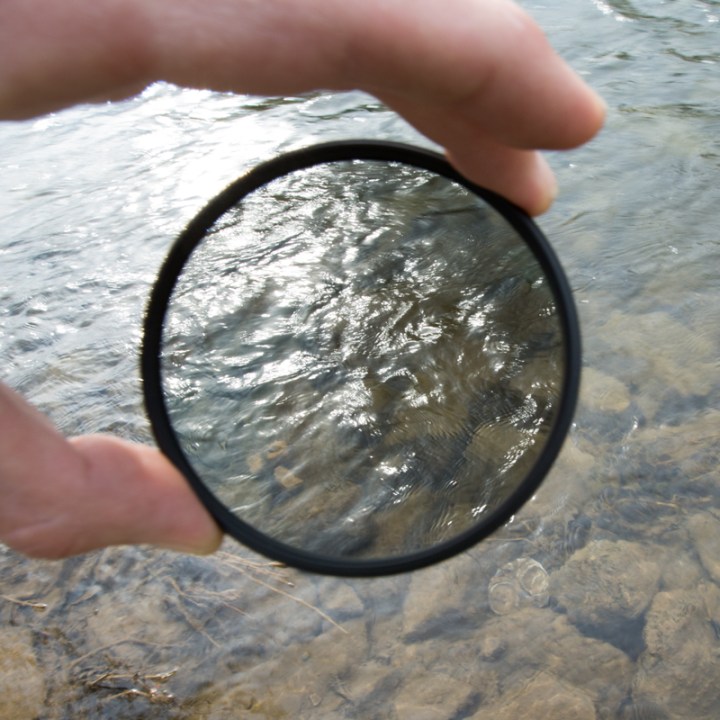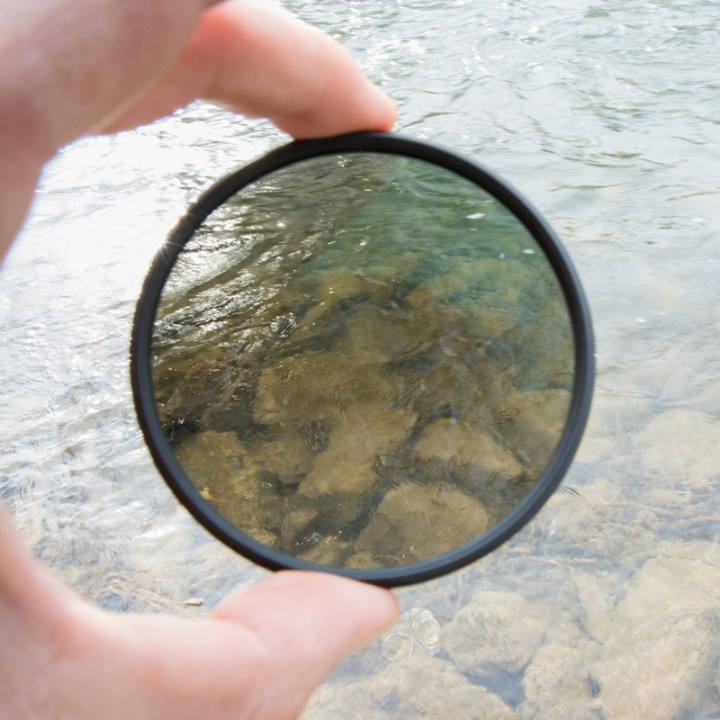One of the major challenges in landscape photography is managing reflected light, especially when working around water. The single best way to subdue reflection is to use a circular polarizing filter (B&H | Amazon) to control the amount of scattered light across the lens in full sun.
Polarizing filters are ideal for contrasting clouds against a hazy blue sky, and removing unwanted glare across water and glass. I like to think of it as sunglasses for my lens.
While many filters can be successfully emulated via software, horizontally polarized light can only be contained at the lens level and is not repairable in post. Click the image below for a more detailed understanding as to how linear and circular polarizing filters specifically work in photography.

Circular polarizers are designed to rotate and adjust freely without decoupling to quickly find the best angle to block any unwanted rays.
In the image below on the left, the filter is in the open position, affecting no change in the image whatsoever. The image on the right has been rotated 180 degrees to the closed position, effectively removing the glare and allowing us to see through the water to the rocks below.
Similarly, our sunglasses are polarized vertically to improve contrast by effectively blocking all horizontal light bouncing from above and below.
.mgl-tiles { display: none; } #mgl-gallery-634efd0f20191 { margin: -5px; width: calc(100% + 10px); } #mgl-gallery-634efd0f20191 .mgl-box { padding: 5px; } @media screen and (max-width: 768px) { #mgl-gallery-634efd0f20191 { margin: -5px; width: calc(100% + 10px); } #mgl-gallery-634efd0f20191 .mgl-box { padding: 5px; } } @media screen and (max-width: 460px) { #mgl-gallery-634efd0f20191 { margin: -5px; width: calc(100% + 10px); } #mgl-gallery-634efd0f20191 .mgl-box { padding: 5px; } }
Normal position
Polarized position
A few things to keep in mind
- Circular polarizers are marketed according to the specific filter thread depth of each lens manufacturer and not necessarily interchangeable, so we do need to be sure to select the correct filter for each specific lens in the bag. Otherwise, the risk of cross-threading will cause the filter to become wedged and permanently damage the lens filter housing.
- Changes in temperature can cause the filter threads to swell and contract, making it difficult to remove at times. This tends to happen when I forget to remove the filter and leave it in the car overnight. If this should occur, all we can do is wait for the temperature to even out and the filter will eventually spin right off. To safely install a polarizer without cross-threading, place the filter to the lens housing and rotate slightly left (as if to loosen) and the threads should click into place. We can now spin to the right and tighten to secure the filter.
- Using a polarizing filter will add a stop to a given exposure so we’ll definitely lose speed in lower light. Yet as the light descends, the need for the polarizer goes with it and we’re free to remove it and regain our stop. If you shoot a lot of real estate, you’ve likely run into this problem moving from exterior to interior. If I’m having trouble metering and can’t buy an interior shot, it’s almost always because I forgot to remove the polarizing filter on the way in.
- And finally to be mindful of autofocus and zoom. As a lens extends outward and inward to acquire focus and/or zoom, any filter attached will rotate with the barrel accordingly, causing our effect to rotate out of position. So we do need to be aware and readjust the polarizer for best results.
It’s important to reiterate that there is no true replacement for redirecting polarized light in post-production. The only solution is to invest in the best sunglasses possible for our lens.
If you’re new to shooting with an interchangeable lens system, or have simply never tried one, adding a quality circular polarizing (CPL) filter to the kit can bring an appealing, native contrast to any photograph captured in full sun.
Tell your story with the second annual Visual Storytelling Conference!
Experience four days of interactive, online training sessions featuring a range of educational content with experienced photographers and content creators. This free event kicks off with a series of technical boot camps to build essential skills, followed by live, online sessions on photography, video, business and social media. Join live from March 10-13, 2022!
